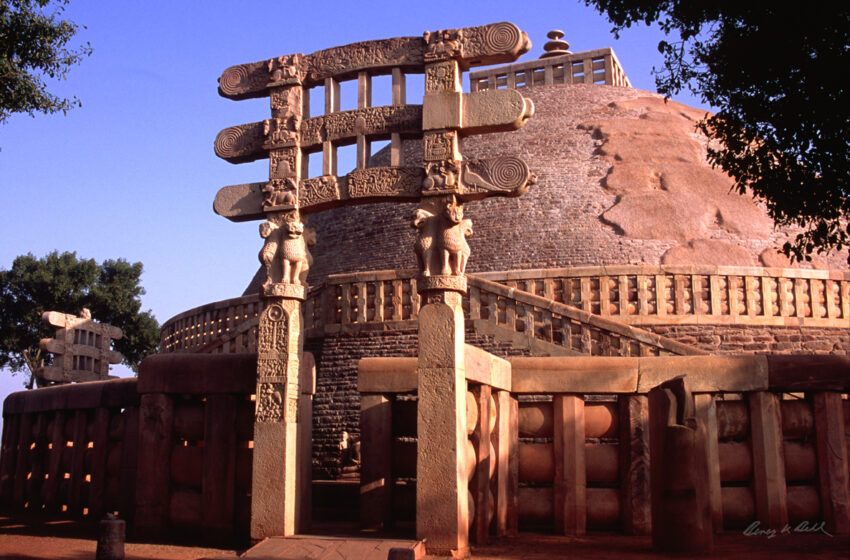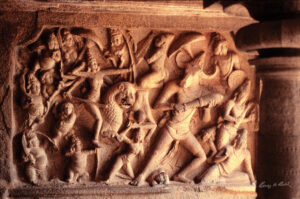Women had an exalted position in ancient India

Sanchi Stupa Grand Gateways, Great Stupa, Sanchi, Madhya Pradesh, India: It was originally made in the 3rd century BC. In the middle of the 2nd century BC, it was doubled in size. Four gloriously carved stone gates or toranas, each 34 feet high, were added to the railings in the 1st century AD. Photograph by Benoy K Behl
Benoy K Behl
Is it not wonderful that about half the patrons of monuments of ancient India were women? It is housewives, nuns, tailors and others who were responsible for the glorious architectural and artistic heritage which we have from early times!
A total of 631 donation inscriptions survive at the Great Stupa at Sanchi. These show that the magnificent art of the toranas (or gateways) of the Sanchi Stupa was patronised by the common people. It was fishermen, tailors, housewives, nuns and others who paid for the making of the grand monument. An individual states that he is the patron of a sculpted pillar. Another states that she is paying for the making of an architrave of the torana. About half the donation inscriptions are of women. The same holds true of the other great monuments of ancient India. Thousands of inscriptions survive in the early monuments all across India, which testify to this. This wondrous heritage was created by the people and very largely by women. Obviously, in ancient times, women in India had the financial independence to patronize places of worship of their own choice.
There is a sense of natural ease in the depiction of interactions between men and women in ancient sculpture, which opens a beautiful window to how warm and easy such relations can be. This is so unlike the constrained, tense and artificial interactions of modern times.
In the BCE period and the early CE period, we find art from which there is much that we can learn. At the early Buddhist caves of Karle and Kondavane, we find depictions of men and women interacting with each other in a way which is easy and joyous. There is a naturalness and grace in these interactions, which shows us how life is meant to be. There is equality and mutual respect between men and women and the women are seen expressing themselves with freedom, warmth and confidence. This is so different from modern life, in which men and women play defined roles and are much more constrained and artificial in their behaviour with each other. There is a grace and ease seen in the art of early times which is extremely inspiring and could help us to shape a modern world with much more peace, equality between the genders, harmony and joy.

In Hindu thought, the personification of courage and the energy within us with which we would combat the demons of our ignorance, is a female deity Durga. In Buddhist thought, while compassion finds a male personification, wisdom is represented in female form.
The theme of Durga vanquishing the demon Mahisha is one of the most popular representations of Indian art. She represents the vigour and power, the determination and courage within us, with which we must battle the evil of our ignorance of the truth. Today we may find it remarkable that, in early Indian thought, these qualities were personified in a female figure. The most beautiful depiction of Mahishasurmardini is in a 7th century cave at Mamallapuram. Another exquisite depiction is in the Virupaksha Temple at Pattadakal.
The two principal qualities of Buddhahood are seen to be Wisdom and Compassion. While compassion is personified in a male deity Avalokitesvara, wisdom and knowledge are represented in female form Prajnaparamita. Thus, we see that the important quality of wisdom and knowledge is visualized in feminine form. Tara, another important female personification in Buddhism, came also to be largely worshipped by the 5th-6th century CE, as is seen in the Buddhist caves of Western India.
Art brings to us attitudes and norms of society, frozen in stone and in colour. These are often a wonderful record of the vision of life in ancient times. Amidst all the noise and clamour of the materialistic world around us, there is so much that we can gain by looking at the simplicity and grace of ancient times.
If you want to know more about the subject, be a part of the online illustrated talk, Position of Women in Ancient India, by renowned art historian and photographer Benoy K Behl on August 27 at 6 pm. No registration or payment is required.
The joining link: https://us06web.zoom.us/j/84080507057?pwd=Ly94MDdZeTJVcG8wZDlTMXRDUG5QZz09
Meeting ID: 840 8050 7057
Passcode: 331379

